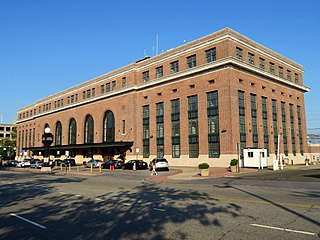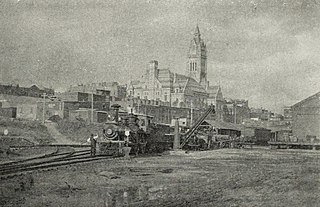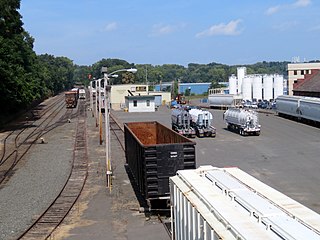
Connecticut is the southernmost state in the New England region of the United States. As of the 2010 Census, it has the highest per-capita income, second-highest level of human development behind Massachusetts, and highest median household income in the United States. It is bordered by Rhode Island to the east, Massachusetts to the north, New York to the west, and the Long Island Sound to the south. Its capital is Hartford and its most populous city is Bridgeport. Historically the state is part of New England as well as the tri-state area with New York and New Jersey, which together make up metropolitan New York City. The state is named for the Connecticut River which approximately bisects the state. The word "Connecticut" is derived from various anglicized spellings of "Quononoquett" (Conanicut), a Mohegan-Pequot word for "long tidal river".

The New York, New Haven and Hartford Railroad, commonly known as The Consolidated or simply as the New Haven, was a railroad that operated in the New England region of the United States from 1872 to December 31, 1968. Founded by the merger of the New York and New Haven and Hartford and New Haven railroads, the company had near-total dominance of railroad traffic in Southern New England for the first half of the 20th century.

Union Station, also known as New Haven Railroad Station or simply New Haven, is the main railroad passenger station in New Haven, Connecticut. It is the third such station in the city of New Haven, preceded by both an 1848 built station in a different location, and an 1879 built station near the current station's location. Designed by noted American architect Cass Gilbert, the present beaux-arts Union Station was completed and opened in 1920 after the previous Union Station was destroyed by fire. It served the New York, New Haven and Hartford Railroad for the next five decades, but fell into decline following World War II along with the United States railroad industry as a whole.

The Providence and Worcester Railroad is a Class II railroad operating in Rhode Island, Massachusetts, and Connecticut, as well as New York via trackage rights. It was originally founded in 1844 to build a railroad between Providence, Rhode Island and Worcester, Massachusetts, and ran its first trains in 1847. The P&W operated independently until 1892, when the New York, New Haven and Hartford Railroad leased it. The P&W continued to exist as a company for the next 85 years until regaining its independence in 1973, after its shareholders launched a fight with Penn Central, which took over the New Haven in 1970, seeking to exit the merger. Upon regaining its independence, the railroad expanded through purchasing a number of railroad lines from the Boston and Maine Railroad and Penn Central successor Conrail. The Providence and Worcester was purchased by railroad holding company Genesee & Wyoming in 2016.

The Central New England Railway was a railroad from Hartford, Connecticut and Springfield, Massachusetts west across northern Connecticut and across the Hudson River on the Poughkeepsie Bridge to Maybrook, New York. It was part of the Poughkeepsie Bridge Route, an alliance between railroads for a passenger route from Washington to Boston, and was acquired by the New York, New Haven & Hartford Railroad in 1904.

The New York and New England Railroad was a major railroad connecting southern New York State with Hartford, Connecticut, Providence, Rhode Island, and Boston, Massachusetts. It operated under that name from 1873 to 1893. Prior to 1873 it was known as the Boston, Hartford and Erie Railroad, which had been formed by several smaller railroads dating back to 1846. After bankruptcy in 1893, the New York and New England Railroad was reorganized and became known as the New England Railroad before its 1898 lease to the competing New York, New Haven and Hartford Railroad. Today, most of the original New York and New England lines have been abandoned; however a portion in Massachusetts is now part of the MBTA's Franklin Line providing commuter rail service to South Station in Boston. The Connecticut Southern Railroad operates freight service on a small portion of the former NY&NE line near East Hartford and Manchester, Connecticut. Other portions in Connecticut and Rhode Island have been converted to rail trails.

The Connecticut Trolley Museum, founded in October 1940, is the oldest incorporated museum dedicated to electric railroading in the United States. The museum is located in East Windsor, Connecticut and is open to the public April through December. The museum features static and moving displays, and self-guided tours of the state's trolley history.

The New Canaan Branch is an 8.2-mile long branch line of the Metro-North Railroad New Haven Line that begins from a junction east of downtown Stamford, Connecticut north to New Canaan. It opened in 1868 as the New Canaan Railroad. As of 2021, all trains operate as local shuttles between Stamford and New Canaan, requiring a transfer at Stamford for continued service to other destinations along the New Haven mainline.

Founded in 1996, the Naugatuck Railroad is a common carrier railroad owned by the Railroad Museum of New England and operated by Naugatuck Railroad on tracks leased by Naugatuck Railroad from the Connecticut Department of Transportation. The original Naugatuck Railroad was a railroad chartered to operate through south central Connecticut in 1845, with the first section opening for service in 1849. In 1887 the line was leased by the New York, New Haven and Hartford Railroad, and became wholly owned by 1906. At its greatest extent the Naugatuck ran from Bridgeport north to Winsted. Today's Naugatuck Railroad runs from Waterbury to the end of track in Torrington, Connecticut. From Waterbury south to the New Haven Line, Metro-North Railroad operates commuter service on the Waterbury Branch.

Connecticut's 2nd congressional district is a congressional district in the U.S. state of Connecticut. Located in the eastern part of the state, the district includes all of New London County, Tolland County, and Windham County, along with parts of Hartford, Middlesex, and New Haven counties. Principal cities include Enfield, Norwich, New London, and Groton.

Bridgeport station is a shared Amtrak, Metro-North Railroad, and CTrail train station along the Northeast Corridor serving Bridgeport, Connecticut and nearby towns. On Metro-North, the station is the transfer point between the Waterbury Branch and the main New Haven Line. Amtrak's inter-city Northeast Regional and Vermonter service also stop at the station, as do some CTrail Shore Line East trains. In addition the transfer point for Greater Bridgeport Transit Authority buses, the departure point for the Bridgeport & Port Jefferson Ferry across Long Island Sound to Port Jefferson, New York, and both the Arena at Harbor Yard and the Ballpark at Harbor Yard are located adjacent to the station.

The Connecticut Company was the primary electric street railway company in the U.S. state of Connecticut, operating both city and rural trolleys and freight service. It was controlled by the New York, New Haven and Hartford Railroad, which also controlled most steam railroads in the state. After 1936, when one of its major leases was dissolved, it continued operating streetcars and, increasingly, buses in certain Connecticut cities until 1976, when its assets were purchased by the state government.

The Hartford and New Haven Railroad (H&NH), founded in 1833, was the first railroad built in the state of Connecticut and an important direct predecessor of the New York, New Haven and Hartford Railroad. The company was formed to connect the cities of New Haven, Connecticut and Springfield, Massachusetts. It built northwards from New Haven, opening its first segment in 1838, and reaching Hartford in December 1839. The company reached Springfield in 1844 under the auspices of the Hartford and Springfield Railroad, a subsidiary chartered in Massachusetts. The Hartford and New Haven merged with the New York and New Haven Railroad in 1872, forming the New York, New Haven and Hartford Railroad.

The New Haven and Northampton Railroad was a railroad originally built alongside a canal between 1847 and 1850 in Connecticut. Leased by the New York and New Haven Railroad from 1849 to 1869, the railroad expanded northwards to Massachusetts and its second namesake city in 1859. Upon the end of the lease in 1869, the company expanded further into Massachusetts, reaching as far north as Shelburne and Turners Falls.
The Maybrook Line was a line of the New York, New Haven and Hartford Railroad which connected with its Waterbury Branch in Derby, Connecticut, and its Maybrook Yard in Maybrook, New York, where it interchanged with other carriers. It was the main east-west freight route of the New Haven until its merger with the Penn Central in 1969.

The Pioneer Valley Railroad is a Class III short line freight railroad operating the former Conrail trackage in the western part of Massachusetts in towns of Westfield, Holyoke, and Southampton. Since being founded in 1982 railroad has been owned by the Pinsly Railroad Company with headquarters in Westfield, Massachusetts.
Mill Plain was a station on the main line of the New York and New England Railroad and later the Maybrook Line of the New York, New Haven, and Hartford Railroad. Opened in 1881, the station was originally located in the Mill Plain area in the western part of Danbury, Connecticut. The station was closed in 1928 and served multiple purposes from 1930 until 2018. The station building was restored and moved to the Danbury Railway Museum in 2019.

Cedar Hill Yard is a classification yard located in New Haven, North Haven, and Hamden, Connecticut. It was built by the New York, New Haven and Hartford Railroad in the early 1890s in and around New Haven's Cedar Hill neighborhood, which gave the yard its name. Electrical catenary for electric locomotives was added to the yard in 1914. To handle increasing traffic as a result of World War I, the yard was greatly expanded between 1917 and 1920 with additional construction along both sides of the Quinnipiac River. The construction project added two humps where railroads cars were sorted into trains by gravity. The yard was further modernized in the 1920s, becoming one of the busiest and most state-of-the-art railroad yards in the United States, and the most important yard in the entire New Haven Railroad system.

Railroads have played an important role in New England ever since the Granite Railway, America's first commercial railway, began operations in Massachusetts in 1826. As industrialization spread across the region, hundreds of railroads were built throughout the 19th century. Railroad mileage peaked around World War I, and from that point on mileage began to shrink. Despite this, railroads continue to be important for freight and passenger transportation in the region, with the New Haven Line holding the title of busiest railroad line in the entire United States.

Hartford Yard is a classification yard located in Hartford, Connecticut. It was originally built by the New York, New Haven and Hartford Railroad. The yard was greatly expanded between 1925 and 1926 to alleviate congestion in the railroad's nearby East Hartford Yard, following the company's purchase in 1917 of 12.5 acres of land in Hartford's North End.


















